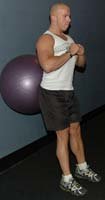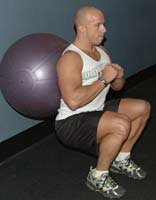
TOPIC: What Is The Best Workout To Improve Your Squat?

The Question:
Squats are amongst the big 3 lifts (bench press, deadlift, squat). Some say that squats are the king of all the exercises.
What is the best workout to improve your squat? Be specific.
How much of a weight increase to your squat can you expect from this workout?
How important are squats to one's workout routine?
Bonus Question: Who would benefit from this type of workout and would you recommend it to others? Explain why.
Show off your knowledge to the world!
The Winners:
- EAGLES56
- BigTruckGuy3500 View Profile
- Veeshmack View Profile
1st Place - EAGLES56

Workout
What Is The Best Workout To Improve Your Squat? Be Specific.
Improving ones squat entails dedicating time towards the perfection of numerous factors which influence ones strength and size gains as well as preventing bodily harm.
Factors To Consider:
Footwear:
Believe it or not, improper foot attire will influence problems ranging from poor posture, to muscular imbalances or even injury. Do not wear shoes which have gel insoles or an "air cushion." The heel should rest upon and push off of a stable base.
Stance:
Foot spacing and which way ones toes point depend on the individual. Those with large quadriceps usually prefer squatting with a closer stance than those with large hips who squat wider. Knees and toes should never point inwards during the squat to prevent injury.
Bar Placement:
The bar should be placed on what is often referred to by powerlifters as the "shelf." This is toughly between the lower traps and upper rear deltoids.
Grip:
Firmly grasping the bar prevents the bar from rolling. If discomfort is presented in the shoulders or wrists, widen the grip. The wider the grip, the higher probability that the bar may slip or roll.
The Walkout:
Aim to stay as close to the rack as possible without it getting in the way on the descent. Do not lock out the knees.
Execution:
After walking the weight out from the rack and inhaling so that the lungs are full of air, begin to farther bend the knees, lowering oneself downward hips first. Hold the air in while sitting back in a manner that the calves are almost be parallel with the wall without falling over backward. Tighten the abs throughout the motion.
The load should be distributed upon the quads and heels, not the knees. Keep the chest high and back between a 45- and 90-degree angle with the floor. Bend both the knees and back together.
Exhale on the way back up to a standing position. Do not lock out the knees. Maintain a slight bend to allow for increased Time Under Tension on the thighs. Perform the entire motion in a fluid and controlled manner (Do not bounce or jerk). Repeat.
Breathing:
Take a deep breath before performing the eccentric (down/negative) portion of the squat. Holding your breath until the concentric (up/positive) and then breathing out through pursed lips relieves a fair deal of pressure exerted on the body throughout the movement.
Advice:
Keep a weight training log. Record sets, reps, weight, supplementation, diet, mood, etc. Perhaps one lacked energy due to too few calories that day which resulted in a poor workout, maybe one had a great workout due to a pre-workout supplement. Documenting these factors assists in gauging progress.
Sample Squat Improving Workouts:
Basic Leg Workout:
- Leg Press: 3 x 6-10
- Squats: 3 x 6-10
- Lunges: 3 x 8-12
- Leg Extensions: 2 x 15-20
- Sanding / Seated Calf Raises: 3 x 20, 30, 40
Volume Approach:
- Front / Back Squat: 8 x 4
- Stiff-Leg Deadlift: 8 x 4
- Lunges: 3 x 10
- Leg Curls: 3 x 10
Pyramid:
- Squat: 5 x 10, 8, 6, 4, 10 (accumulation sets; add weight each set, drop weight down substantially on the last set)
5 x 5:
- Leg Press: 5 x 5
- Squats: 5 x 5
- Lunges: 5 x5
***Recommended***
- 20 Rep Squats
At the end of a workout or on a separate day, try performing one set of squats consisting of 20 repetitions. This method is tried and true when it comes to results.
Emphasize contraction and continuous muscle tension. Gradually add weight each or every other workout. Adding even 2.5 pounds per side each workout will deliver results.
Expected Weight Increase
How Much Of A Weight Increase To Your Squat Can You Expect From This Workout?
The increase in weight on ones squat will depend on a plethora of factors ranging from training experience, time frame, frequency, diet, rest and personal health and wellness. To achieve maximal results, train in conjunction with a solid nutrition plan and set aside adequate time to allow the body to rest and recover.
The Importance Of Squats
How Important Are Squats To One's Workout Routine?
Squats have been dubbed the king of exercises. Squats incorporate over 70% of the muscles in the body and increase growth hormone secretion which is necessary is becoming a true beast. High repetition squats are also a tough form of cardio which incinerates fat. This exercise should be considered essential in nearly anybody's workout regimen.
To conclude; squats increase muscle mass, abolish fat and improve cardiovascular capacity (endurance).
Bonus Question
Who Would Benefit From This Type Of Workout And Would You Recommend It To Others? Explain Why.
The workouts included in this article could benefit anybody from the beginner to the advanced trainee. I would recommend these workouts to those who do not have a pre-existing medical complication. Always talk to a doctor before performing any type of training program. Squats host a multitude of benefits that carry over into day-to-day life from picking up boxes to carrying bags up the stairs.
References:
- www.bodybuilding.com/fun/animalpak54.htm
- www.bodybuilding.com/fun/randy4.htm
- www.bodybuilding.com/fun/matt48.htm
EAGLES56

2nd Place - BigTruckGuy3500
View This Author's BodySpace Here.

The best type of workout to improve squats is a holistic one. As some say, squats are the king of all exercises, and is practically a full body exercise. Why, when the squat involves so many muscles, would you not work out those muscles separately to help your squat.
Let's start by analyzing what gets worked out when squatting. Obviously your legs are supposed to take the large brunt of the weight, that's a given. Both your quads, hamstrings, and glutes will work a lot if you correctly execute your squat.
But let's not forget what's keeping you from falling over. Your abdominals and lower back. Both of them are helping to stabilize you throughout the entire motion. Any imbalance, and they work to keep you upright. Next, your shoulders and traps take a large load directly off your bones. They provide a cushion that keeps the bar from grinding against your bones. Not to mention, they act as stabilizers for the bar.
Workout
So, a workout that is designed to help improve your squat would have to include all of these muscles.
Starting with the obvious, you have to squat to improve your squat. There are no two ways about it. It is important to put your muscles through a range of motion that is similar to what you are trying to accomplish in order for them to learn how to work efficiently and effectively through that range of motion.
Secondly, squatting must be done through as full of a range of motion as you can physically/medically accomplish. This doesn't mean hurt yourself going too low, but you should definitely be past a 90-degree knee bend. Some people even go all the way to a squat position where they are almost touching their butts to the floor.

 Squatting Routine:
Squatting Routine:
A good squatting routine should start with warm-up sets, move into a working rep range, and then usually have 1 cool-down set just to keep things loose. And assuming you are trying to improve strength, your working sets should be between 4-6 reps.
- Squats
1 x 12
1 x 8
3 x 6
1 x 4
2 x 15 body weight
 Click Here For A Printable Log Of Squats Routine.
Click Here For A Printable Log Of Squats Routine.
This should allow you to work in the optimal zone for power, and the 2 sets of body weight squats, while they may look awkward in the gym will feel good the next morning when your legs aren't as stiff as boards.
Note: if you are new to squatting, please ensure that you have 100% correct form before moving into heavy loads. Improper form can lead to serious injuries, or just extra wear and tear on your joints that will lead to complications down the road.
Abdominal Workout:
For abdominal work, it is important to have strong abs that can stabilize a lot of weight, but that can also keep you stabile for a long time. An example abdominal work out could be:
- Weighted sit-ups: 3 x 30
- Flutter kicks: 3 x 40 (at a 4 count)
- Side crunches: 2 x 40 (each side)
 Click Here For A Printable Log Of Abdominal Workout.
Click Here For A Printable Log Of Abdominal Workout.
This way, your main abs, as well as your obliques should improve in their ability to stabilize a lot, as well as for a long time.
Shoulders & Traps Workout:
For your shoulders and traps, you are looking at mostly just the rear shoulder, and middle back. Rows are excellent for hitting this area. They incorporate the rear deltoid and middle back/traps well. Also, we're looking primarily for mass in this exercise, so we'll pick a rep range that tends to work that well.
- Cable rows: 3 x 6-10
- One-arm DB rows: 2 x 8-12 (each arm)
 Click Here For A Printable Log Of Shoulders & Traps Workout.
Click Here For A Printable Log Of Shoulders & Traps Workout.
Lower Back Workout:
For the lower back, one can take two approaches. Assuming we are all powerlifters/bodybuilders, I'm going to go into what we all want to hear. DEADLIFTS!
Now here it is important to realize that deadlifts are near as intense, sometimes more so, than squats, and it is important to make sure that you do not burn yourself out doing too high a volume of both. But deadlifts really strengthen the lower back, hamstrings and glutes. And that is another thing to be careful of - overdoing it on your hamstrings and glutes when doing a lot of deadlifts and squats.
An alternative for deadlifts can be hyperextensions with moderate amounts of weights held at your chest or above your head. With deadlifts, it is usually best to not do more than 4-5 sets, as the lower back muscles are some of the slowest recovering muscles in the body.
Hyperextensions can, however be done for many more sets, and even be combined with deadlifts. Typically 12-18 is a good rep range for hyperextensions. A minimum of 4 should be performed with a ceiling of about 8 depending on your level.
 Click Here For A Printable Log Of Lower Back Workout.
Click Here For A Printable Log Of Lower Back Workout.
Legs:
Lastly, let's refocus on the legs. Providing the most force will be your legs, hands down and even with the best back, shoulders and abs, you won't be able to move a thing if you don't have legs. So it is important to give a little extra emphasis on these via simpler exercises like leg extensions, hamstring curls, and leg press.
Hitting each one of those exercises for 2-or-3 sets on leg day should really do a number on your muscle fibers and provide a lot of damage for good growth.
 Click Here For A Printable Log Of Legs Workout.
Click Here For A Printable Log Of Legs Workout.
While all the above exercises could be done in a single routine, it would probably be best to isolate them on to their own days for whichever respective muscle group they fit into.
Expected Weight Increase:
How Much Of A Weight Increase To Your Squat Can You Expect From This Workout?
Over the course of a few weeks, you could see a relatively good return on investment if you are putting in the time and effort to perform each and every exercise correctly and intensely enough.
Numbers will vary drastically from person to person and someone taking creatine or a natural test booster, for example, will likely see a larger gain than someone not taking supplements. But by making sure to put more emphasis on all the muscles involved in squatting, you will definitely see an increase beyond what you would have gotten otherwise.
 |
The Bodybuilding.com Store: Creatine Products Sorted By Top Sellers Simply put, creatine monohydrate is the most popular and effective bodybuilding supplement on the market. [ Creatine Top Sellers! ] |
The Importance Of Squats
How Important Are Squats To One's Workout Routine?
Like stated above, squats are pivotal in someone's routine. They are holistic exercises that, some studies have shown, can promote the body's natural release of extra growth hormone. Aside from that, squats can single handedly keep your upper body from seriously outpacing your lower body in size as well as strength gains. Nobody wants to be the big muscular guy with chicken legs down below.
Bonus Question
Who Would Benefit From This Type Of Workout And Would You Recommend It To Others? Explain Why.
Anyone looking for serious strength gains and looking at improving their posture could really benefit from this workout. I would recommend it to anyone who is looking for the above, or who has a hard time with squats or has chicken legs. The main reason is, they will be able to benefit from it a lot and will appreciate the gains the most.
I would not, however recommend squatting individuals with disk or back problems without consulting a physician. Squatting too heavy can compress the spine, and with spinal conditions your spine may be unable to safely handle the load.

3rd Place - Veeshmack
View This Author's BodySpace Here.

Squats are probably, if not the most productive workout for the lower body as it hits multiple muscles in the legs and can be altered to hit them from different angles. This being said, if ones goal was to strictly increase overall squat strength, squats would be used as the base and building block of this workout.
When lifting with increasing the weight being the only goal in your mind, it is a good idea to focus on a 5x5 scheme as it has been shown to have great effects on strength.
So using squats as the base to our workout, each workout will consist of 2-3 squat variations and 2-3 other movements through the legs. Remember to always go as low as you can on squats to receive the most out of each rep.
Because these workouts will hit most angles of your legs and can be tiring, it will be split into 2 separate workouts and I would recommend getting two days of rest between each of these workouts. So for example, do workout 1 one Tuesday and workout 2 on Friday. You can use the in between days to recover and workout the upper body.
Before starting the workout, perform a good dynamic stretching workout to loosen up the muscles and obtain optimal performance.
Workout 1:
- Squats
- Lunges
- Deadlifts
- Side Split Squats
- Calf Raises
- Squat Jumps
 Click Here For A Printable Log Of Workout 1.
Click Here For A Printable Log Of Workout 1.
Workout 2:
- Front Squats
- Stiff-leg Deadlifts
- Step Ups
- One-legged Squats
- Isometric Wall Sits
- Squats
 Click Here For A Printable Log Of Workout 2.
Click Here For A Printable Log Of Workout 2.
Since large lower body compound movements can do a number on you, it's suggested that you get lots of rest and always lift with a spotter.
Expected Weight Increase
How Much Of A Weight Increase To Your Squat Can You Expect From This Workout?
There is no set number to how much stronger you will get. This workout is only accountable for so much of your gains. In order to get the absolute most out of your workout you will need a good diet with lots of protein, optimal rest, and knowledge of how the body works.
Gains are also going to be limited to genetics; you might be a hard gainer and it will take more work to see results, or you may be about to hit the upper limit of your strength allowance, but you can always keep pushing and try to get better.
That being said, I would suggest trying to increase the weight by 5-10 pounds on your squat every 2 weeks and judge your progress from there.
The Importance Of Squats
How Important Are Squats To One's Workout Routine?
Squats are key to everybody's workout. Most people think since they are not powerlifters, athletes or bodybuilders, they don't need to work their legs. They could not be more wrong. Not only will they get you more powerful and stronger, but also they will help keep your body in proportion. I'm not saying to do the above workout and focus 2 days to improving squats, but they need to be done.
Bonus Question
Who Would Benefit From This Type Of Workout And Would You Recommend It To Others? Explain Why.
This workout is not designed for the average person who just wants to look good at the beach. This workout was created for athletes, bodybuilders and powerlifters trying to obtain raw power and a skull-crushing lower body physique.
Other than those falling in the athlete and bodybuilding category, I recommend this workout to anyone who wants a defined and strong lower body who is simply looking for something different or who has hit a plateau.



